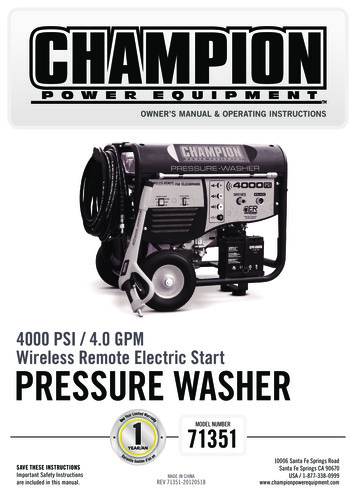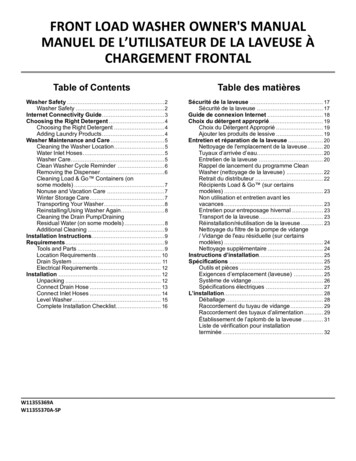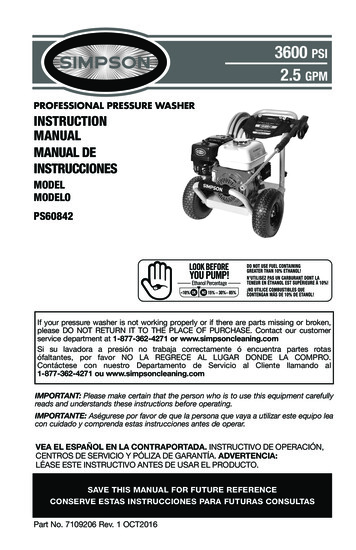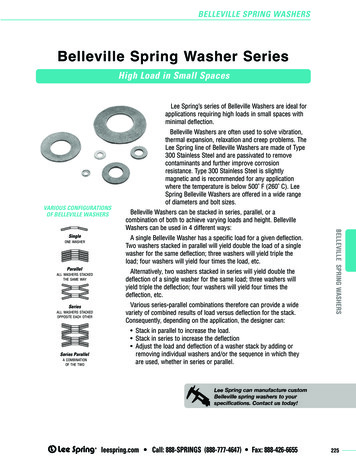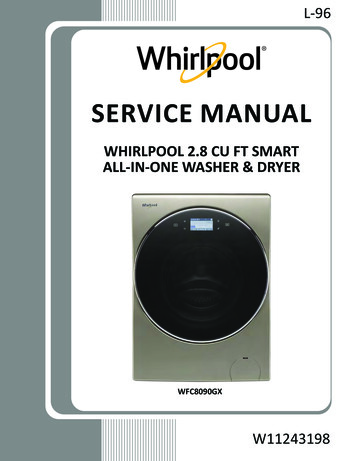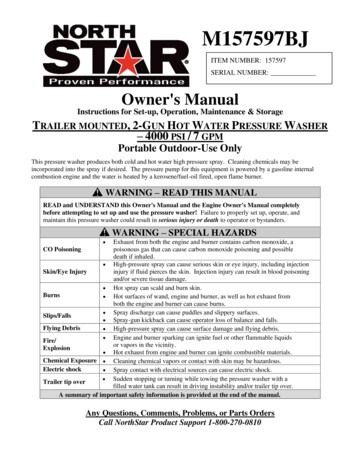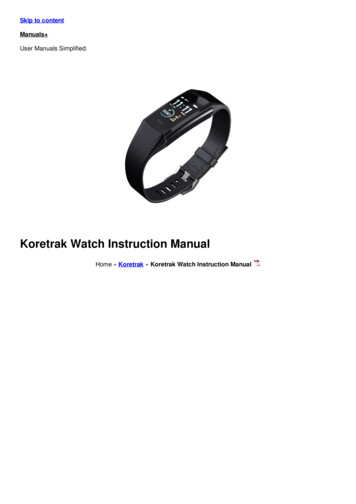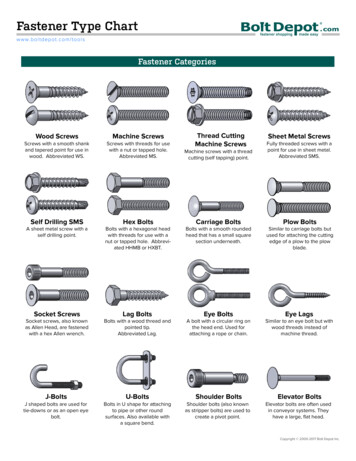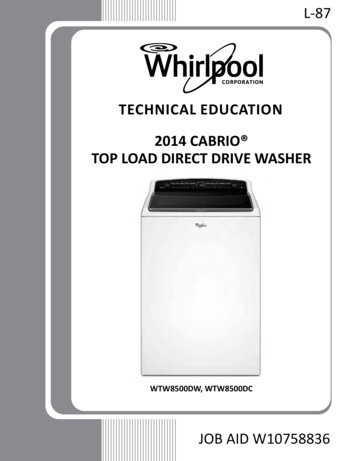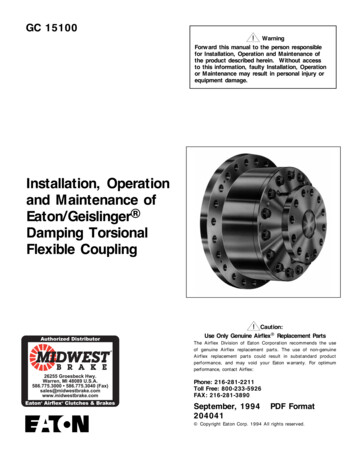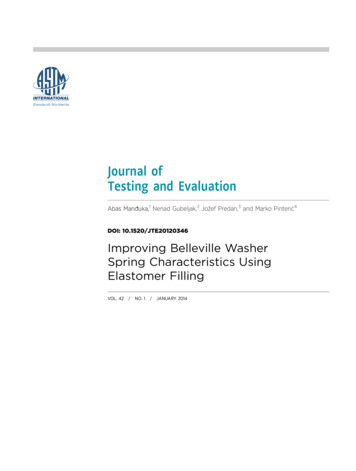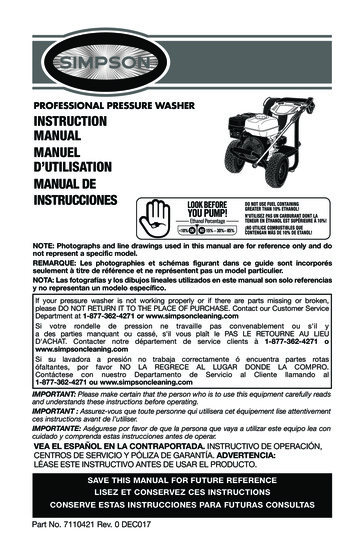
Transcription
PROFESSIONAL PRESSURE WASHERINSTRUCTIONMANUALMANUELD’UTILISATIONMANUAL DEINSTRUCCIONESMAX.RPMMIN.NOTE: Photographs and line drawings used in this manual are for reference only and donot represent a specific model.REMARQUE: Les photographies et schémas figurant dans ce guide sont incorporésseulement à titre de référence et ne représentent pas un model particulier.NOTA: Las fotografías y los dibujos lineales utilizados en este manual son solo referenciasy no representan un modelo específico.If your pressure washer is not working properly or if there are parts missing or broken,please DO NOT RETURN IT TO THE PLACE OF PURCHASE. Contact our Customer ServiceDepartment at 1-877-362-4271 or www.simpsoncleaning.comSi votre rondelle de pression ne travaille pas convenablement ou s'il ya des parties manquant ou cassé, s'il vous plaît le PAS LE RETOURNE AU LIEUD'ACHAT. Contacter notre département de service clients à 1-877-362-4271 owww.simpsoncleaning.comSi su lavadora a presión no trabaja correctamente ó encuentra partes rotasófaltantes, por favor NO LA REGRECE AL LUGAR DONDE LA COMPRO.Contáctese con nuestro Departamento de Servicio al Cliente llamando al1-877-362-4271 ou www.simpsoncleaning.comIMPORTANT: Please make certain that the person who is to use this equipment carefully readsand understands these instructions before operating.IMPORTANT : Assurez-vous que toute personne qui utilisera cet équipement lise attentivementces instructions avant de l’utiliser.IMPORTANTE: Aségurese por favor de que la persona que vaya a utilizar este equipo lea concuidado y comprenda estas instrucciones antes de operar.VEA EL ESPAÑOL EN LA CONTRAPORTADA. INSTRUCTIVO DE OPERACIÓN,CENTROS DE SERVICIO Y PÓLIZA DE GARANTÍA. ADVERTENCIA:LÉASE ESTE INSTRUCTIVO ANTES DE USAR EL PRODUCTO.SAVE THIS MANUAL FOR FUTURE REFERENCELISEZ ET CONSERVEZ CES INSTRUCTIONSCONSERVE ESTAS INSTRUCCIONES PARA FUTURAS CONSULTASPart No. 7110421 Rev. 0 DEC017
SAFETY GUIDELINES - DEFINITIONSThis manual contains information that is important for you to know and understand.This information relates to protecting YOUR SAFETY and PREVENTINGEQUIPMENT PROBLEMS. To help you recognize this information, we use thesymbols below. Please read the manual and pay attention to these symbols.DANGER: Indicates an imminently hazardous situation which, if not avoided,will result in death or serious injury.WARNING: Indicates a potentially hazardous situation which, if not avoided,could result in death or serious injury.CAUTION: Indicates a potentially hazardous situation which, if not avoided, mayresult in minor or moderate injury.NOTICE: Indicates a practice not related to personal injury which, if not avoided,may result in property damage.IMPORTANT SAFETY INSTRUCTIONSDANGER: Carbon Monoxide. Using an engine indoors can kill you inminutes. Engine exhaust contains high levels of carbon monoxide (CO), apoisonous gas you cannot see or smell. You may be breathing CO even if youdo not smell engine exhaust. NEVER use an engine inside homes, garages, crawlspaces or other partlyenclosed areas. Deadly levels of carbon monoxide can build up in these areas.Using a fan or opening windows and doors does NOT supply enough fresh air. ONLY use outdoors and far away from open windows, doors and vents. Theseopenings can pull in engine exhaust. Even when the engine is used correctly, CO may leak into your home. ALWAYSuse a battery-powered or battery backup CO alarm in your house. Read andfollow all directions for CO alarm before using. If you feel sick, dizzy or weakat anytime, move to fresh air immediately. See a doctor. You could have carbonmonoxide poisoning.WARNING: Do not operate this unit until you read this instruction manual andthe engine instruction manual for safety, operation and maintenance instructions. Ifyou have any questions regarding the product, please contact our customerservice department at www.simpsoncleaning.com.DANGER: Risk of injection or severe injury. Keep clear of nozzle. Do notdirect discharge stream at persons or live animals. This product is to be usedonly by trained operators.WARNING: This product and its exhaust can expose you to chemicals includinglead and lead compounds, and carbon monoxide, which are known to the State ofCalifornia to cause cancer and birth defects or other reproductive harm. For moreinformation go to www.P65Warnings.ca.gov.WARNING: Always wear appropriate personal hearing and other protectionduring use. Under some conditions and duration of use, noise from this productmay contribute to hearing loss.2- ENG
WARNING: This product may not be equipped with a spark-arresting muffler.If the product is not equipped and will be used around flammable materials oron land covered with materials such as agricultural crops, forest, brush, grass orother similar items, then an approved spark arrester must be installed and is legallyrequired in the state of California. It is a violation of California statutes section130050 and/or sections 4442 and 4443 of the California Public Resources Code,unless the engine is equipped with a spark arrester, as defined in section 4442, andmaintained in effective working order. Spark arresters are also required on someU.S. Forest Service land and may also be legally required under other statutesand ordinances.SAVE THESE INSTRUCTIONSDANGER: RISK OF EXPLOSION OR FIREWHAT CAN HAPPENHOW TO PREVENT IT Spilled gasoline and it’s vapors can Shut off engine and allow it to cool beforebecome ignited from cigarette sparks,adding fuel to the tank.electrical arcing, exhaust gases and Use care in filling tank to avoid spilling fuel.hot engine components such asMove pressure washer away from fuelingthe muffler.area before starting engine. Heat will expand fuel in the tank which Keep maximum fuel level 1/2" (12.7 mm)could result in spillage and possiblebelow bottom of filler neck to allowfire explosion.for expansion. Operating the pressure washer in an Operate and fuel equipment in wellexplosive environment could result inventilated areas free from obstructions.a fire.Equip areas with fire extinguisher suitablefor gasoline fires. Materials placed against or near the Never operate pressure washer in an areapressure washer can interfere withcontaining dry brush or weeds.its proper ventilation features causingoverheating and possible ignition ofthe materials. Muffler exhaust heat can damage Always keep pressure washer a minimumpainted surfaces, melt any materialof 4' (1.2 m) away from surfaces (suchsensitive to heat (such as siding,as houses, automobiles or live plants)plastic, rubber, vinyl or the pressurethat could be damaged from mufflerexhaust heat.hose, itself), and damage live plants. Improperly stored fuel could lead to Store fuel in an OSHA approved container,accidental ignition. Fuel improperlyin a secure location away from work area.secured could get into the hands ofchildren or other unqualified persons. Use of acids, toxic or corrosive Do not spray flammable liquids.chemicals, poisons, insecticides, orany kind of flammable solvent withthis product could result in seriousinjury or death.3 - ENG
DANGER: RISK TO BREATHING (ASPHYXIATION)WHAT CAN HAPPENHOW TO PREVENT IT Breathing exhaust fumes will cause Operate pressure washer in a wellserious injury or death! Engineventilated area. Avoid enclosed areasexhaust contains carbon monoxide,such as garages, basements, etc.an odorless and deadly gas. Never operate unit in or near a locationoccupied by humans or animals. Some cleaning fluids contain Use only cleaning fluids specificallysubstances which could cause injuryrecommended for high pressure washers.to skin, eyes or lungs.Follow manufacturers recommendations.Do not use chlorine bleach or any othercorrosive compound.DANGER: RISK OF FLUID INJECTION AND LACERATIONWHAT CAN HAPPENHOW TO PREVENT IT Your pressure washer operates at fluid Inspect the high pressure hose regularly.pressures and velocities high enoughReplace the hose immediately if it isto penetrate human and animal fleshdamaged, worn, has melted fromwhich could result in amputation orcontacting the engine, or shows any signsother serious injury. Leaks causedof cracks, bubbles, pinholes, or otherby loose fittings or worn or damagedleakage. Never grasp a high pressurehoses can result in injection injuries.hose that is leaking or damaged.DO NOT TREAT FLUID INJECTION Never touch, grasp or attempt to coverAS A SIMPLE CUT! See a physiciana pinhole or similar water leak on theimmediately!high pressure hose. The stream ofwater IS under high pressure and WILLpenetrate skin. Never place hands in front of nozzle. Direct spray away from self and others. Make sure hose and fittings are tightenedand in good condition. Never hold ontothe hose or fittings during operation. Do not allow hose to contact muffler. Never attach or remove wand or hosefittings while system is pressurized. When using replacement lances or gunswith this pressure washer, DO NOT usea lance and/or lance/gun combinationthat is shorter in length than what wasprovided with this pressure washer asmeasured from the nozzle end of thelance to the gun trigger. Injuries can result if system pressure To relieve system pressure, shut offis not reduced before attemptingengine, turn off water supply and pull gunmaintenance or disassembly.trigger until water stops flowing. Use only accessories rated equalto or higher than the rating of thepressure washer.4- ENG
DANGER: RISK OF INJURY FROM SPRAYWHAT CAN HAPPENHOW TO PREVENT IT High-velocity fluid spray can cause Always wear ANSI-approved Z87.1objects to break, projecting particlessafety glasses. Wear protective clothingat high speed.to protect against accidental spraying. Never point wand at or spray peopleor animals. Light or unsecured objects can Always secure trigger lock whenbecome hazardous projectiles.wand is not in service to preventaccidental operation. Never permanently secure trigger in pullback (open) position. DANGER: RISK OF UNSAFE OPERATIONWHAT CAN HAPPENHOW TO PREVENT ITUnsafe operation of your pressure Do not use chlorine bleach or any otherwasher could lead to serious injury orcorrosive compound.death to you or others. Become familiar with the operation andcontrols of the pressure washer. Keep operating area clear of all persons,pets and obstacles. Do not operate the product when fatiguedor under the influence of alcohol or drugs.Stay alert at all times. Never compromise the safety features ofthis product. Do not operate machine with missing,broken or unauthorized parts. Never leave wand unattended while unitis running.If proper starting procedure is not If engine does not start after two pulls,followed, engine can kickback causingsqueeze trigger of gun to relieve pumpserious hand and arm injury.pressure. Pull starter cord slowly untilresistance is felt. Then pull cord rapidlyto avoid kickback and prevent hand orarm injury.The spray gun/wand is a powerful Keep children away from the pressurecleaning tool that could look like a toywasher at all times.to a child.Reactive force of spray will cause Do not overreach or stand on an unstablesupport.gun/wand to kickback, and couldcause the operator to slip or fall or Do not use pressure washer whilemisdirect the spray. Improper controlstanding on a ladder.of gun/wand can result in injuries to Grip gun/wand firmly with bothself and others.hands. Expect the gun to kickbackwhen triggered.5 - ENG
DANGER: RISK OF INJURY OR PROPERTY DAMAGE WHENTRANSPORTING OR STORINGWHAT CAN HAPPENHOW TO PREVENT IT Fuel or oil can leak or spill and could If pressure washer is equipped witha fuel shut-off valve, turn the valve toresult in fire or breathing hazard.the OFF position before transporting toSerious injury or death can result.avoid fuel leaks. If pressure washer is notFuel or oil leaks will damage carpet,equipped with a fuel shut-off valve, drainpaint or other surfaces in vehiclesthe fuel from tank before transporting.or trailers.Only transport fuel in an OSHA-approved Oil could fill the cylinder and damagecontainer.the engine if the unit is not stored or Always place pressure washer ontransported in an upright position.a protective mat when transportingto protect against damage to vehiclefrom leaks. Always transport and store unit in anupright position. Remove pressurewasher from vehicle immediately uponarrival at your destination.DANGER: RISK OF ELECTRICAL SHOCKWHAT CAN HAPPENHOW TO PREVENT IT Spray directed at electrical outlets or Unplug any electrically operated productswitches, or objects connected to anbefore attempting to clean it. Direct sprayelectrical circuit, could result in a fatalaway from electric outlets and switches.electrical shock.DANGER: RISK OF CHEMICAL BURNWHAT CAN HAPPENHOW TO PREVENT IT Use of acids, toxic or corrosive Do not spray acids, gasoline, kerosene,chemicals, poisons, insecticides, oror any other flammable materials with thisany kind of flammable solvent with thisproduct. Use only household detergents,product could result in serious injurycleaners and degreasers recommendedor death.for use with pressure washers. Wear protective clothing to protecteyes and skin from contact withsprayed materials.6- ENG
WARNING: RISK OF BURSTINGWHAT CAN HAPPENHOW TO PREVENT IT Over inflation of tires could result in Use a tire pressure gauge to check theserious injury and property damage.tires pressure before each use and whileinflating tires; see the tire sidewall for thecorrect tire pressure.NOTE: Air tanks, compressors and similarequipment used to inflate tires can fill smalltires similar to these very rapidly. Adjustpressure regulator on air supply to no morethan the rating of the tire pressure. Add airin small increments and frequently use thetire gauge to prevent over inflation. High-velocity fluid spray directed at On pressure washers rated abovepneumatic tire sidewalls (such as1600 PSI (11032 kPa) use the widestfound on automobiles, trailers andfan spray (40º nozzle) and keep thespray a minimum of 8" (20 cm) from thethe like) could damage the sidewallpneumatic tire sidewall. Do not aim sprayresulting in serious injury.directly at the joint between the tire andrim.WARNING: RISK OF HOT SURFACESWHAT CAN HAPPENHOW TO PREVENT IT Contact with hot surfaces, such as During operation, touch only the controlengine exhaust components, couldsurfaces of the pressure washer. Keepresult in serious burn.children away from the pressure washerat all times. They may not be able torecognize the hazards of this product.WARNING: RISK OF INJURY FROM LIFTINGWHAT CAN HAPPENHOW TO PREVENT IT Serious injury can result from The pressure washer is too heavy to beattempting to lift too heavy an object.lifted by one person. Obtain assistancefrom others before lifting.SAVE THESE INSTRUCTIONSFOR FUTURE USE7 - ENG
QUICK SETUP GUIDE WARNING: To reduce the risk of injury, read the pressure washer instructionmanual and the engine instruction manual before operating pressure washer.Install theHandleSlide the handleassembly onto theframe. (if equipped) Alignholes in the top handlewith the mounting holesin the handle assembly.Secure with saddlebolts and knobs.AAdd/Check OilThe engineis shippedwithout oil. Beforestarting engine, addthe oil provided. Checkoil level prior to eachuse. Refer to EngineOwner’s Manual forcomplete procedure.BAdd GasolineIn a wellventilatedoutdoor area add fresh,high quality, unleadedgasoline with a pumpoctane rating of 86 orhigher. Do not overfill.Wipe up spilled fuelbefore starting theengine. Refer to EngineOwner's Manual forcomplete procedure.CORIMPORTANT: Ethanol ShieldTM (sold separately) is a fuel stabilizer that helpseliminate and prevent ethanol related problems in power equipment. Follow theinstructions on the container and add to the gasoline.QUICK START GUIDEDANGER: Never run engine indoors or in enclosed, poorly ventilated areas. Engineexhaust contains carbon monoxide, an odorless and deadly gas. Risk of fluid injection and laceration. When using the high-pressure setting,DO NOT allow the high-pressure spray to come in contact with unprotectedskin, eyes or with any pets or animals. Serious injury will occur.8- ENG
Connect GardenConnect HighHose to Pump2 Pressure Hoseto PumpThread thegarden hose toConnect the highthe pump inlet.pressure hose tothe pump outlet.1Connect HighPressure Hoseto Spray GunThread the other endof the high pressurehose to the spray gun.3ORConnect SprayWand to SprayGunThread the spraywand into the endof the spray gun.4Release Air fromSystemRelease allair from pump andhigh pressure hose bydepressing trigger until asteady stream of water ispresent. Approximately30 seconds.7Connect QCNozzles to SprayWandPull quick connectcoupler back and insertnozzle. Release quickconnect coupler andtwist nozzle to make sureit is secure in coupler.58ORTurn WaterFaucetCompletely OnDo not run the unitwithout water supplyconnected and turned on.Use Cold Water Only.6 tart engine. SeeSEngine Owner'sManual forcorrectprocedure.30 SWARNING: This Guide is not a substitute for reading the operator's manual.User must read and understand operator's manual before using this product.9 - ENG
GET TO KNOW THE PRESSURE WASHERNOTE: Photographs and line drawings used in this manual are for referenceonly and do not represent a specific model.Compare the illustrations with your unit to familiarize yourself with the location ofvarious controls and adjustments. Save this manual for future reference.G1KLDCBMAX.RPMMIN.AEJBASIC ELEMENTS OF A PRESSURE WASHER (FIG. 1)A.B.C.D.E.F.G.H.I.HIHigh Pressure Pump: Increases the pressure of the water supply.Engine: Drives the high pressure pump. Refer to the Engine Owner's Manualfor location and operation of engine controls.High Pressure Hose: Carries the pressurized water from the pump to the gunand spray wand.Spray Gun: Connects with spray wand to control water flow rate, directionand pressure.Quick-Connect Spray Wand: Allows the user to quickly change outhigh pressure nozzles. See How To Use Spray Wand instructions inOperation section.Detergent Siphon Hose (not shown): Feeds cleaning agents into the pump to mixwith the water. See How To Apply Chemicals/Cleaning Solvents instructionsin Operation section.HandleFramePump Outlet10- ENG
J.K.L.Pump InletQuick Connect NozzlesNozzle HolderBASIC ELEMENTS OF AN ENGINERefer to the Engine Owner's Manual for location and operation of engine controls.Choke Control: Opens and closes carburetor choke valve.Starter Grip: Pulling starter grip operates recoil starter to crank engine.Engine Switch: Enables and disables ignition system.ASSEMBLY INSTRUCTIONS (FIG. 2–4)1.2.3.Locate and remove all loose parts from the carton.Cut four corners of the carton from top to bottom and lay the panels flat.(Figure 2) Slide the handle assembly (G) onto the frame (H)and secure withsaddle bolts and knobs.OR(Figure 2A) Align holes in the top handle (S) with the mounting holes in thehandle assembly (G). Insert saddle bolts (DD) through aligned holes andsecure top handle to handle assembly with knobs (EE). Tighten until snug.3.NOTICE: Risk of personal injury. Avoid placing hands between handle and framewhen assembling to prevent pinching.22ASGGGEEH4.HRemove the colored quick-connect nozzles (K) from the plastic bag and insertthem into correct grommet on the nozzle holder (L). Nozzles are color codedto match colored nozzles on label.2BKL5.DDConnect wand (E) to gun (D). Tighten securely.11 - ENG
6.Attach high pressure hose (C) to gun (D). Tighten securely.43DDOREDCCNOTICE: The engine is shipped without oil. Before starting engine, add the oilprovided. Damage to the engine will occur if the engine is run without oil, thisdamage will not be covered under warranty.NOTICE: The high-pressure pump was filled with oil at the factory. Always check oillevel before using (refer to Maintenance for more information).OPERATIONPRESSURE WASHER TERMINOLOGYPSI: Pounds per Square Inch. The unit of measure for water pressure. Also usedfor air pressure, hydraulic pressure, etc.PSI*: Pounds per Square Inch. The unit of measure for water pressure. Also usedfor air pressure, hydraulic pressure, etc.GPM*: Gallons per Minute. The unit of measure for the flow rate of water.* Rated Pressure and Rated Water Flow is within manufacturing tolerance of( /- 10%).Bypass Mode: Allows water to re-circulate within the pump when the gun trigger isnot pulled. This feature allows the operator to release the trigger gun and repositionthemselves without having to turn the engine off in between cleaning actions. WARNING: Do not allow the unit to run for more than two minutes withoutthe gun trigger being pulled. This could cause overheating and damage tothe pump. When the temperature inside the pump rises too high, the thermalrelief valve will open and release a spray of water from the pump to lower theinternal temperature. The valve will then close.Thermal Relief Valve (P, Fig. 5): When the temperature inside the5Ppump rises too high, this valve will open and release a gush ofwater in an effort to lower the temperature inside the pump. Thevalve will then close. NOTE: Thermal relief valve location will varydepending on the pump type.Detergent Injection System: Mixes cleaners or cleaning solventswith the water to improve cleaning effectiveness.Water Supply: All pressure washers must have a source of water. The minimumrequirements for a water supply are 20 PSI and 5 Gallons Per Minute. If your watersource is a well, the garden hose length can only be 30 ft. (9 m) max.WARNING: To reduce the possibility of contamination always protectagainst backflow when connected to a potable water system.12- ENG
PRESSURE WASHER OPERATING FEATURES RESSURE ADJUSTMENTS (FIG. 6)PThe pressure setting is preset at the factory to achieve optimum pressure andcleaning. If you need to lower the pressure, it can be accomplished by thesemethods.1. Back away from the surface to be cleaned. The further away you are, theless the pressure will be on the surface to be cleaned.2. Change to the 40 nozzle (white). This nozzle delivers a less powerful streamof water and a wider spray pattern. Refer to How To Use Spray Wand.3. (if equipped) This pressure washer’s highpressure pump is equipped with an additional 6feature that allows the pressure setting to beadjusted. To lower the pressure, turn the pressure control knob on the pump counterclockwise tothe desired pressure.To return the pump pressure to the factory setting, turn the pressure controlknob on the pump clockwise until it stops.NOTICE: DO NOT overtighten the pressure control knob, if overtightened the knobCOULD break and result in immediate loss of water pressure and costly repairs tothe unit.DIAL-N-WASH ADJUSTMENT (FIG. 7, 8) (IF EQUIPPED)1. Choose the correct high pressure nozzle (0 , 15 or 40 ) for the job to beperformed. Refer to How To Use Spray Wand.2. The Dial-N-Wash is shipped in the MAX pressure setting, the MAX pressurebar is aligned with the arrow (R) on the collar as shown in Figure 7.Rotating the Dial-N-Wash (Q) counterclockwise until it stops places it in theMIN pressure setting, the arrow (R) will align with the MIN pressure bar asshown in Figure 8.87RRQAdjust the pressure by rotating theDial-N-Wash (Q) clockwise e, aligning the arrow withthe desired pressure bar on theDial-N-Wash.NOTE: To apply chemicals the black low pressure nozzle must be installed andthe Dial-N-Wash must be in the MAX pressure setting.13 - ENG
HOW TO USE SPRAY WANDThe nozzles for the spray wand are stored in the nozzle holder on the panel assembly.Colors on the panel identify nozzle location and spray pattern. Refer to the followingchart to choose the correct nozzle for the job to be performed.CHANGING NOZZLES ON SPRAY WAND (FIG. 9)DANGER: Risk of fluid injection. Do not direct discharge stream towardpersons, unprotected skin, eyes or any pets or animals. Serious injurywill occur.WARNING: Flying objects could cause risk of serious injury. Do notattempt to change nozzles while pressure washer is running. Turn engine offbefore changing nozzles.1. Pull quick-connect coupler (E) back and insert nozzle (K).92. Release quick-connect coupler and twist nozzle tomake sure it is secure in coupler.WARNING: Flying object could cause risk of seriousinjury. Ensure nozzle is completely inserted in quickconnect socket and quick-connect collar is fully engaged(forward) before squeezing gun trigger.NOZZLE COLORESPRAY PATTERNUSESSURFACES**0 powerfulpinpoint forspot cleaning ofhard, unpaintedsurfaces or forhigh reach areasunpainted metalor concrete;DO NOT use on wood15 intense cleaningof unpaintedhard surfacesgrills, driveways, concreteor brick walkways,unpainted brick or stucco25 standard cleaning yard tools, sidewalks, lawnnozzle for mostfurniture, unpainted siding,applicationsstucco, gutters and eaves,concrete, brick surfaces40 cleaning ofpainted ordelicate surfacesauto/RV, marine, wood,painted brick and stucco,vinyl, painted sidinglow pressureapplies cleaningsolutionsLow pressure spray issafe on all surfaces.Always verify compatibilityof cleaning solutionprior to use.RedYellowGreenWhiteBlackK14- ENG
**NOTICE: The high pressure spray from your pressure washer is capable ofcausing damage to surfaces such as wood, glass, automobile paint, auto stripingand trim, and delicate objects such as flowers and shrubs. Before spraying, checkthe item to be cleaned to assure yourself that it is strong enough to resist damagefrom the force of the spray.HOW TO APPLY CHEMICALS/CLEANING SOLVENTS (FIG. 10)Applying chemicals or cleaning solvents is a low pressure operation. NOTE: Useonly soaps and chemicals designed for pressure washer use. Do not use bleach.To Apply Chemicals:101. Ensure detergent siphon hose (F, Figure 10) is attachedFto barbed fitting location near high pressure hoseconnection of pump as shown. NOTE: The barbedfitting location will vary depending on the pump type.2. Place other end of detergent siphon hose withfilter on it into container holding chemical/cleaningsolution. NOTE: For every 7 gallons of water pumped1 gallon of chemical/cleaning solution will be used.3. Install low pressure (black) nozzle into quick connect fitting of spray wand, seeHow To Use Spray Wand paragraph in this section.4. After use of chemicals, place detergent siphon hose into container of cleanwater and draw clean water through chemical injection system to rinse systemthoroughly. If chemicals remain in the pump, it could be damaged. Pumpsdamaged due to chemical residue will not be covered under warranty.NOTE: Chemicals and soaps will not siphon if the black soap nozzle is not installedon the spray wand.STARTING (FIG. 11–14)WARNING: To reduce the risk of injury, read the pressure washer instructionmanual and the engine instruction manual before starting pressure washer.DANGER: Risk of fluid injection and laceration. When using the highpressure setting, DO NOT allow the high pressure spray to come in contactwith unprotected skin, eyes, or with any pets or animals. Serious injurywill occur. Your washer operates at fluid pressures and velocities high enough to penetratehuman and animal flesh, which could result in amputation or other serious injury.Leaks caused by loose fittings or worn or damaged hoses can result in injectioninjuries. DO NOT TREAT FLUID INJECTION AS A SIMPLE CUT! See a physicianimmediately!DANGER: Carbon Monoxide. Using an engine indoors can kill you inminutes. Engine exhaust contains high levels of carbon monoxide (CO), apoisonous gas you cannot see or smell. You may be breathing CO even if youdo not smell engine exhaust. Breathing exhaust fumes will cause serious injury or death! Engine exhaustcontains carbon monoxide, an odorless and deadly gas. Operate pressure washer in a well-ventilated area. Avoid enclosed areassuch as garages, basements, etc. Never operate unit in or near a location occupied by humans or animals.15 - ENG
WARNING: Risk of Fire, Asphyxiation and Burn. Never fill fuel tank whenengine is running or hot. Do not smoke when filling fuel tank. Never fill fuel tank completely. Fill tank to 1/2" (12.7 mm) below bottom of fillerneck to provide space for fuel expansion. Wipe any fuel spillage from engine andequipment before starting engine. DO NOT let hoses come in contact with very hot engine muffler during orimmediately after use of your pressure washer. Damage to hoses from contact withhot engine surfaces will NOT be covered by warranty.NOTICE: Risk of property damage. Never pull water supply hose to move pressurewasher. This could damage hose and/or pump inlet. DO NOT use hot water, use cold water only. Never turn water supply off while pressure washer engine is running or damage topump will result. DO NOT stop spraying water for more than two minutes at a time. Pump operates inbypass mode when spray gun trigger is not pressed. If pump is left in bypass modefor more than two minutes internal components of the pump can be damaged.If you do not understand these precautions, please contact our customer servicedepartment at www.simpsoncleaning.comPrior to starting, refer to your engine manual for proper starting procedure.1. In a well ventilated outdoor area add fresh, high quality, unleaded gasoline witha pump octane rating of 86 or higher. Do not overfill. Wipe up spilled fuel beforestarting the engine. Refer to Engine Owner's Manual for correct procedure.IMPORTANT: Ethanol ShieldTM (sold separately) is a fuel stabilizer that helpseliminate and prevent ethanol related problems in power equipment. Follow theinstructions on the container and add to the gasoline. OTICE: Use of fuels with greater than 10% ethanol areNnot approved for use in this product per EPA regulationsand will damage the unit and void the warranty.Check engine oil level. Refer to Engine Owner's Manual for correct procedure.Check pump oil level. Th
MANUAL MANUEL D'UTILISATION MANUAL DE INSTRUCCIONES SAVE THIS MANUAL FOR FUTURE REFERENCE LISEZ ET CONSERVEZ CES INSTRUCTIONS CONSERVE ESTAS INSTRUCCIONES PARA FUTURAS CONSULTAS RPM Part No. 7110421 Rev. 0 DEC017 If your pressure washer is not working properly or if there are parts missing or broken, please DO NOT RETURN IT TO THE PLACE OF .
